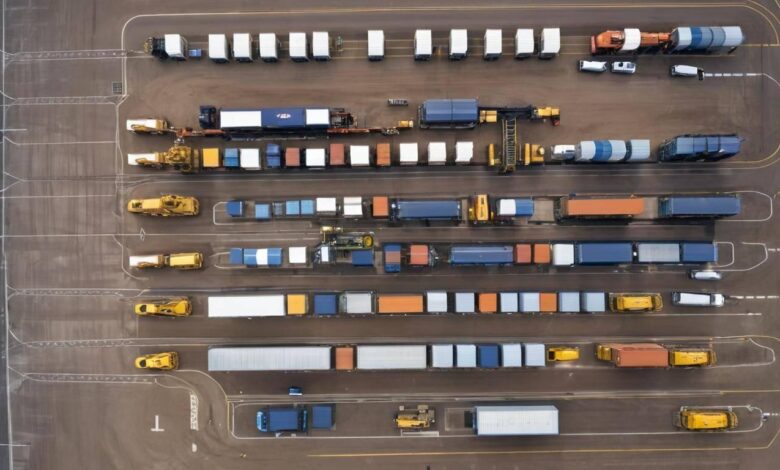How Machinery Transport Companies Use Tech to Cut Costs: A Comprehensive Guide

In an industry where every penny counts, machinery transport companies are constantly on the lookout for ways to cut costs without sacrificing efficiency. It’s a challenging balancing act, one that has become even more complex with the rapid advancements in technology. On one hand, tech solutions promise to streamline operations and lower expenses. On the other, their integration can seem daunting and fraught with uncertainties.
Through careful research and real-world examples, we’ve found that certain technologies bring clear benefits that far outweigh their initial drawbacks. From optimizing transport routes to automating fleet management, these solutions offer tangible savings and enhance operational performance. Imagine knowing precisely where each machine is at all times or preemptively addressing maintenance needs before they turn into costly repairs. This is no longer just a possibility — it’s a reality for companies willing to embrace modern tools. Let’s explore how these advancements are reshaping machinery transport and cutting costs along the way.
Machinery transport companies leverage advanced Transportation Management Systems (TMS) to optimize route planning, minimize fuel consumption, and reduce labor costs. Additionally, the integration of Internet of Things (IoT) devices enables real-time tracking and monitoring, enhancing operational efficiency and cost savings so customers can get cheap machinery shipping rates.
Leveraging GPS Technology for Machine Transport
GPS technology has become a game-changer in the machinery transport industry, offering unparalleled benefits that significantly impact cost reduction and operational efficiency. By harnessing the power of GPS-based systems, companies gain access to real-time and accurate location data, enabling them to optimize routes, avoid congested areas, and select the most efficient paths to their destinations. As a result, machinery transport companies can minimize fuel consumption and reduce travel time, ultimately trimming down operational costs.
Fleet managers play a pivotal role in utilizing GPS technology effectively. They monitor vehicle speed, ensuring that drivers maintain efficient speeds and avoid unnecessary idling. By keeping a close eye on these key performance indicators, companies can make data-driven decisions to enhance driver behavior and overall fleet efficiency. The ability to analyze historical data on vehicle speed and driving patterns provides insights that can lead to improvements in fuel consumption and reduced wear and tear on vehicles.
Furthermore, GPS technology offers an enhanced level of transparency and visibility into the transportation process. It allows for proactive monitoring of delivery schedules, helping companies provide accurate arrival times to clients—ultimately contributing to improved customer satisfaction and retention. Real-time tracking of machinery shipments also adds a layer of security, enabling companies to provide reliable updates to clients about the location and estimated time of arrival of their equipment.
Consider this scenario: A machinery transport company utilizes GPS technology to track its fleet of vehicles carrying heavy construction equipment. Through real-time monitoring, they are able to identify an alternate route due to unexpected traffic congestion. By swiftly rerouting the vehicles, they avoid potential delays and successfully deliver the equipment within the scheduled timeframe. This not only prevents costly hold-ups but also enhances their reputation for reliability among clients.
This technology has proven itself as a cost-effective tool for machinery transport companies, leading to substantial savings in fuel costs and vehicle maintenance while significantly improving service quality. In fact, research indicates that optimized GPS routes can save up to 20% on fuel costs, resulting in notable financial benefits for businesses operating in the machinery transport sector.
The use of GPS technology in machinery transport demonstrates its remarkable capacity to deliver operational efficiencies while concurrently achieving substantial savings in fuel costs—a critical factor in promoting profitability and sustainability within the industry.
Automated Fleet Management Systems
Automated fleet management systems are akin to having a super-smart assistant who keeps an eye on every vehicle in your fleet all the time. It’s not just about tracking their location on a map; it’s about ensuring everything runs as smoothly and efficiently as possible.
Imagine this: When you’re driving, wouldn’t it be nice to have a system that can tell you if there’s a problem with your car before it becomes a big issue? That’s precisely what these systems offer for machinery transport companies. They integrate various technologies—such as telematics (the way information is transmitted from one place to another), sensors, and specialized software—to help streamline operations.
One of the most significant benefits of using automated fleet management systems is the ability to access real-time data on vital aspects of vehicle operation. These systems provide insights into vehicle maintenance needs, driver behavior, and route efficiency, enabling managers to stay informed about maintenance or repairs required before an issue arises.
For instance, companies like Fleet Complete offer platforms that enable transport managers to schedule regular maintenance checks automatically. This feature significantly reduces downtime and minimizes the risk of unexpected breakdowns—almost like having a crystal ball that predicts when something may go wrong with a vehicle so you can fix it before it happens.
Results from recent studies show just how impactful these automated systems can be. They’ve been shown to cut maintenance costs by up to 15% and improve vehicle utilization by as much as 20%, potentially saving substantial amounts of money and time for your machinery transport business.
Enhancing Efficiency and Safety
It’s not solely about saving money; these systems also play a direct role in improving safety. By analyzing data on driver behavior, transport companies can identify and address risky driving habits, ultimately decreasing the chances of accidents.
Keep in mind: A well-run fleet is not just about delivery speed but also about safety for everyone involved.
If a driver is repeatedly speeding or braking hard, the system can flag this behavior, prompting managers to address it with additional training or counseling, thus fostering a safer work environment for everyone on the road.
As we can see, automated fleet management systems are not just about cutting costs—they are powerful tools to enhance efficiency, ensure safety, and optimize fleet performance.
Moving beyond the influence of technology on operational efficiency, let’s now scrutinize another key aspect critical to cutting costs in machinery transport—the strategic investments in fuel-efficient engines.
Fuel-Efficient Engine Investments
In the world of machinery transport, fuel stands as a significant cost, and investing in fuel-efficient engines can be a game-changer. Modern engines, featuring advanced technologies like hybrid or alternative fuels, are designed with the promise of significant fuel savings. Companies are constantly pushing the boundaries of engineering to develop engines with advanced combustion techniques that can greatly improve fuel efficiency, sometimes by up to 25%.
Engines with improved combustion techniques efficiently convert energy from fuel into power, thereby reducing wastage and optimizing energy usage. This not only leads to considerable cost savings for machinery transport companies but also contributes to environmental conservation efforts by reducing harmful emissions.
Compliance with Stringent Emission Standards
Companies like Cummins and Volvo, well-established names in the engine manufacturing industry, have been at the forefront of producing engines that not only aim for exceptional fuel efficiency but also comply with strict emission standards. By using such engines, machinery transport companies not only reduce their environmental impact but also minimize their fuel costs significantly.
Fun Fact: Did you know that some of these engines are so efficient that they release significantly lower levels of greenhouse gases as compared to older models? It’s one way machinery transport companies contribute to a greener planet while trimming down their expenses.
Nowadays, sustainability is not just a buzzword; it’s a mindful approach that many businesses are adopting. By investing in modern, fuel-efficient engines, machinery transport companies not only cut down on operational costs but also align themselves with eco-friendly practices. This dual benefit makes it a wise investment in the long run.
The shift towards fuel-efficient engines is undoubtedly revolutionizing the machinery transport industry by offering substantial cost savings and contributing positively to environmental sustainability.
Real-Time Tracking Solutions
Real-time tracking is a game-changer for the machinery transport industry! With real-time tracking solutions, companies can have continuous visibility of their vehicles and equipment. Imagine a digital map displaying the exact location of your machinery in transit, its speed, and any unexpected stops or delays.
This digital marvel is made possible through Internet of Things (IoT) devices and cloud-based platforms. IoT devices act like superheroes connecting machinery to the internet, while cloud-based platforms serve as the secret lairs where all the data is stored and processed.
By leveraging the power of these technologies, machinery transport companies can furnish customers with precise delivery updates and enhanced visibility into their equipment’s journey. Picture being able to inform a customer exactly when their machinery will arrive, instilling peace of mind and fostering trust in your services.
Two popular platforms facilitating real-time tracking in the machinery transport industry are Geotab and Samsara. These platforms offer comprehensive features like GPS tracking, engine diagnostics, and even driver safety monitoring. Yet the true gem for transport companies is the ability to generate real-time tracking links that can be shared with customers. This not only promotes transparency but also significantly boosts customer satisfaction.
Moreover, real-time tracking solutions not only benefit customers; they also work wonders for the companies themselves. By providing accurate ETA (Estimated Time of Arrival) information, companies can reduce customer inquiries and related administrative overhead by up to 30%. Just imagine slashing one-third of those phone calls asking about delivery status!
Consider a construction company that has ordered a heavy-duty crane for an important project. With real-time tracking provided by their machinery transport company, they can monitor its journey from the dispatch center to the project site in real time. They receive regular updates on its location and estimated arrival time, allowing them to plan their operations efficiently and prevent any unnecessary downtime.
The ability to accurately track the location and status of machinery in transit not only elevates customer satisfaction but also streamlines operational efficiency for machinery transport companies. This is truly technology working miracles in the transport industry!
As we continue our exploration into cost-saving measures, let’s now examine how transport companies are cutting logistical expenses to enhance their bottom line.
Cutting Logistical Expenses
Optimizing logistical expenses is pivotal for machinery transport companies to stay ahead in today’s market. Luckily, advancements in data analytics and machine learning offer innovative opportunities for cutting costs throughout the supply chain. By leveraging these technologies astutely, companies can streamline operations, boost efficiency, and realize significant cost savings.
One of the key ways technology aids in cutting logistical expenses is through the use of data analytics. This involves analyzing historical data to forecast demand accurately, plan optimal inventory levels, and make informed decisions to minimize excess stock. By identifying patterns and trends in demand, machinery transport companies can avoid overstocking or shortages, leading to more efficient resource utilization and reduced carrying costs.
Moreover, machine learning algorithms play a crucial role in load planning optimization. These AI-powered tools can suggest the most efficient ways to consolidate shipments, thereby reducing the number of trips and associated costs. By intelligently optimizing load planning, machinery transport companies can effectively minimize fuel consumption and labor costs while maximizing the utilization of available resources.
For instance, consider an AI-powered load planning tool that takes into account various factors such as payload capacity, delivery deadlines, and route efficiency. It can determine the most cost-effective approach to consolidating shipments, resulting in fewer trips and substantial cost savings. Research indicates that effective use of these tools can lead to a noteworthy reduction in logistical expenses by up to 10%, offering a significant competitive advantage for machinery transport companies.
This data-driven approach not only enhances operational efficiency but also enables proactive decision-making based on accurate insights acquired from historical data. As a result, the business strategies align more closely with actual demand patterns, reducing unnecessary expenses while potentially increasing overall productivity.
In this high-stakes game of strategic cost management and leveraging technology for competitive advantage, it’s vital to remain vigilant on all fronts. Let’s now shift our focus to another critical aspect—the use of technology to enhance security in machinery transport operations.
Enhancing Security with Technology
When it comes to transporting high-value machinery, security is a top concern for logistics companies and clients alike. Advanced technology has emerged as a game-changer in the domain of cargo security, offering innovative solutions to mitigate the risks associated with transportation. By integrating cutting-edge security measures into the supply chain, companies can enhance the protection of valuable assets and reduce the likelihood of theft or tampering.
RFID (Radio Frequency Identification) tags and blockchain verification are two invaluable tools in the arsenal of secure transport. These technologies ensure traceability and authenticity of goods throughout the entire transit process, offering real-time tracking from departure to arrival. Any attempts at unauthorized access or tampering can be immediately flagged, allowing for swift intervention to safeguard the cargo.
Telematics systems also play a vital role in bolstering security during transportation. By leveraging GPS and sensors, telematics solutions enable fleet managers to monitor and analyze the movement of machinery in transit, addressing unexpected deviations from planned routes or stops promptly to prevent potential security breaches. The real-time visibility provided by telematics empowers logistical teams to take proactive measures against any unauthorized activities.
Understanding these technological advancements, companies like Arviem have stepped up to offer comprehensive cargo monitoring solutions that prioritize security during transportation. Their end-to-end monitoring systems not only track the location and condition of high-value machinery but also provide crucial insights into environmental elements such as temperature and humidity to ensure optimal handling.
According to recent statistics, the widespread adoption of advanced security technologies has demonstrated tangible results in reducing theft losses during transport. Companies that have embraced these measures have recorded a substantial decrease in theft losses by up to 15%, underscoring the efficacy of employing state-of-the-art security solutions in protecting high-value machinery throughout its journey.
By integrating RFID tags, blockchain verification, and telematics systems into their operations, machinery transport companies can fortify their security measures and instill greater confidence in their clients regarding the safety and integrity of their valuable assets.
Innovative technologies have revolutionized the landscape of machinery transport, paving the way for advanced route optimization techniques that maximize efficiency and minimize costs.
Advanced Route Optimization
In the fast-paced world of machinery transport, every minute and every mile counts. Advanced route optimization takes the already intricate art of planning travel routes to a whole new level. Imagine a system that not only considers the shortest distance between two points but also factors in traffic patterns, road conditions, and delivery schedules to chart the most efficient path. This is the power of transport management systems (TMS) armed with sophisticated algorithms.
These algorithms are driven by artificial intelligence that continuously processes real-time data to dynamically reroute vehicles when necessary, thereby bypassing potential delays. One key area where these technologies shine is in their ability to adapt on the fly. Let’s say unexpected traffic congestion arises due to an accident or construction; the TMS can swiftly calculate alternate routes, ensuring minimal impact on delivery schedules while also yielding significant time and cost savings.
Consider this: AI-driven route optimization has been shown to reduce overall travel time and fuel consumption by an impressive 18%. This kind of efficiency isn’t just good for business; it also carries positive environmental implications, lessening the carbon footprint associated with extended travel and heavy fuel consumption. Companies like Descartes and Route4Me offer robust route planning tools that seamlessly integrate with existing fleet management systems. These solutions are designed to elevate operational logistics by harnessing the power of intelligent, data-driven decision-making.
It’s important to note that while traditional navigation tools may provide basic directions from point A to point B, they often lack the adaptability and foresight required for optimizing complex transport operations. This is where cutting-edge route optimization algorithms step in, delivering tailored solutions that account for multifaceted variables while aligning with the unique demands of machinery transport companies.
Embracing sophisticated route optimization tools isn’t just about fine-tuning travel plans; it’s about redefining how machinery transport companies operate, unlocking higher levels of productivity, reliability, and cost efficiency.
By integrating advanced route optimization into their operations, machinery transport companies can revolutionize their efficiency and competitiveness in a constantly evolving industry.





